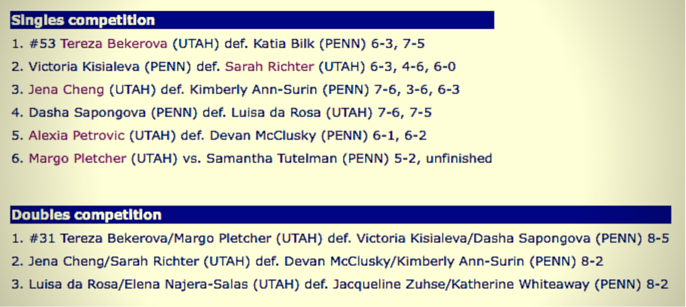5 Variants of Dual Match Play

As some of you might be aware of, there are different college divisions and in each of those divisions, various conferences. There's the NCAA I of course, which enjoys most popularity among tennis fans and attention in the media universe. NCAA II, NCAA III, and NAIA are typically schools with smaller athletic programs. Finally, Junior & Community Colleges (NJCAA) are 2-year institutions, which also have athletic programs and available scholarships.
In order to go with the time there have been constant changes and adaptions in the match format regulations. The most recent innovation, we covered some weeks ago in an edition of our Friday Scholarship Guide. This one is without doubt one of the most revolutionary ones, but limited to one conference so far: New cheering rules in Big 12 Conference. But also other parts of the sport are subject to modifications in order to adjust tennis to the context: college sports.
We understand that prospective student-athletes and college tennis fans often lack an understanding of which match formats apply in which college division and frankly, it is not an easy one. How is match play in the Mid-American Conference (NCAA I) different from the Gulf South Conference (NCAA II) or the Crossroads League (NAIA), even though we're talking the same sport in the same country?
If you go through some of the match recaps of dual matches, you will come across results which look different from each other. You would see a couple unfinished matches in one box score, but all finished in another. You would see a third set match tie-break in one match and a normal set to 6 in another dual match. And why is it some play doubles to 8 games and other teams to 6? We'll attempt to shed some light on the various rules, which are out there today.

Dual Match
"Dual match" is a phrase commonly and frequently used in college tennis coverage. But what does it actually mean? Other terms which are used interchangeably are "team meet", "dual team meet", "dual meet" or "dual meet match".
The definition of a dual match is the following:
"Dual tennis matches are team competitions on a collegiate level between 2 teams held typically at one of either school. The team meet consists of 6 singles matches and 3 doubles matches (or in reverse order), which are played at the same time."
All collegiate play is governed by the same administering organization (ITA) and the specific collegiate rules can be found in the USTA 2015 Handbook.
Set of regulations (ITA, divisions, conferences)
Some of the most important rules and variations of dual match play are highlighted below. It's important to know that specific division or conference rules may replace the existing ITA framework:
1. 3 doubles
- Played as one set to 6, with a tie-break at 6/6
- Played as an 8-game pro set, with a tie-break at 7/7
2. 6 singles
- Played as a general best-of-3 set singles match
- Played as a best-of-3 set singles match, with a match tie-break in the third set
3. Team point format
Singles matches always count 1 full point. Doubles matches either count 1 full point or the team winning 2 or more doubles takes 1 total point.
- 7-point format (e.g. final scores 4/3 or 6/1)
- 9 total format (e.g. final scores 5/4 or 7/2)
4. Warm-up
- 5 minute warm-up
- No warm-up
5. Completion of matches
- All matches to be completed
- Shortened completion of remaining matches
If the team meet has already been won by either of the teams, a shortened match format shall be applied. This means essentially that a match tie-break is played instead of the third set.
- Termination of remaining matches. All remaining matches are to be stopped and do not count towards the playing record of the athletes. It typically says "unfinished" next to the match.
Rule application
Which rules apply depends on several factors, such as where do the two teams come from?
- ...the same division
- ...the same conference; or
- ...have the two coaches agreed on following a different set of rules for the particular match day
NCAA I
As NCAA I is often the showpiece of college tennis and setting the trends for other divisions, it's worth highlighting the current match format:
- Team matches start with 3 doubles, followed by 6 singles (3-6 format)
- Doubles matches are played one set to 6
- Singles matches are played 2 out of 3 sets
- 7 total team points to be won
- No warm-up with opponents
- Completion of matches is recommended
However, some of the above elements have been decided on very recently and implemented only in February this year.
NCAA II
The match format in NCAA II is 3 doubles followed by 6 singles (3-6 format) and 9 total team points to be won.
NCAA III
The match format in NCAA II is 3 doubles followed by 6 singles (3-6 format) and 9 total team points to be won.
NAIA
The match format in NAIA is 3 doubles followed by 6 singles (3-6 format) and 7 total team points to be won.
NJCAA
The match format in NJCAA is 6 singles followed by 3 doubles (6-3 format) and 9 total team points to be won.
Why Change The Rules?
Why change the rules of tennis in the first place? After all, it's a sport, which lives off its rich tradition around the world. But college tennis is in a fierce competition with other attractive college sports for more news coverage, support from athletic departments and of course a broader fan base.
University of Florida women's head coach, Mr. Thornqvist said:
"As we continue in our quest to enhance the status and attendance of college tennis, I am excited to try new formats this year. I expect them to be both shorter as well as more exciting for the fans. I'm encouraged by the college tennis community's commitment to increase market share in what is a very competitive sports landscape and am convinced format change is paramount."
Thornqvist in ITA Q&A
On the same issue, athletic director Mr. Cass said:
"The recommendations being made are very positive, especially given the changes happening to college athletics."
Tim Cass, New Mexico Deputy Athletic Director
Weaker tennis divisions don't have the same need and pressure to get a larger crowd of spectators as NCAA Division I schools do, which is the reason D-I schools work hard on reinventing the college tennis match day experience.
No-ad scoring
Another area, which was also part of the change in regulation before this season is the (re-)implementation of the no-advantage ("no-ad") rule. Again, different from pro-tennis singles matches and the way the sport is being played globally. But very interesting and solid reasons for the ITA make this an exciting college tennis reform.
Come back next Friday to read more about the no-ad movement happening!
Are you in your final years of high school and thinking: "Who cares about the rules? I just want to play college tennis?" Excellent - then sign up for free on Smarthlete right now and connect with the coaches on our tennis recruiting platform!